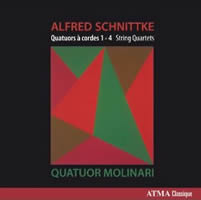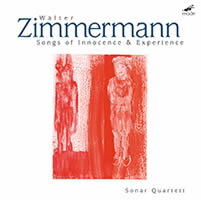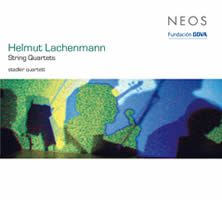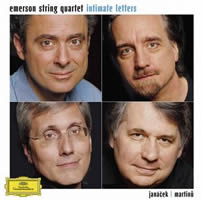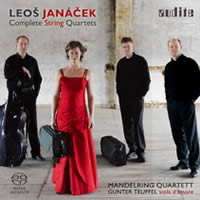String Theory 10: 23 Quartets, etc.
|
Grant Chu Covell [November 2012.]
Alfred SCHNITTKE: String Quartet No. 1 (1966); String Quartet No. 2 (1980); String Quartet No. 3 (1983); String Quartet No. 4 (1989); Canon in Memoriam Igor Stravinsky (1971). Quatuor Molinari: Olga Ranzenhofer, Frédéric Bednarz (vlns), Frédéric Lambert (vla), Pierre-Alain Bouvrette (vlc). Atma ACD2 2634 (2 CDs) (http://www.atmaclassique.com/). Schnittke’s four make a mismatched family. The acerbic No. 1 with deceptively generic movement titles, Sonata, Canon and Cadenza, could be any 1960s effort mimicking Schoenberg or Carter. Despite rash outbursts, No. 2 would be the most traditional, perhaps even Romantic, with Russian tunes and customary answers to phrases. The extroverted Third portrays Schnittke’s approachable polystylistic style, corralling De Lassus, Beethoven and Bruckner amid an unpredictable and wholly incomprehensible design. No light shines from the charred Fourth, an alienating morose and fatalistic opus evidence of post-stroke struggle. Humor banished, this black hole emanates discomfort and malaise. The Molinari gear these shifts marvelously well, the doing of which had to have taken a psychic toll. The order (disc one: Nos. 3, 1, 2; disc two: No. 4, Canon) delineates each quartet’s personality. Maybe I admire the Beethoven Quartet’s grit in No. 2 (MFCD 915) or harbor a fondness for No. 4’s ABQ premiere (EMI CDC 7 54660 2 with Rihm’s Fourth). As a collection, this stands far above the Kronos’ sloppy 1998 set (Nonesuch 79500-2).
“Songs of Innocence & Experience.” Walter ZIMMERMANN: 10 Fränkische Tänze (1977); Keuper (1980); Festina Lente (1987); Songs of Innocence & Experience (1996/2004); Die Sorge geht über den Fluß (1989-91, 2001)*; Taula/Novo Ben (2003)**. Sonar Quartet: Suzanne Zapf*, Kirsten Harms (vlns), Nikolaus Schlierf** (vla), Cosima Gerhardt (vlc). mode 245/6 (2 CDs) (http://www.moderecords.com/). I perused these discs searching for the experience mentioned in the title. Truth be told, Zimmermann’s folksy tunes and rusticated timbres emulate innocence. The 10 Fränkische Tänze imitate a glass harmonica with scordatura and natural harmonics. Two versions bookend the entire program, the first has feathery string drones whereas the second does not. Tunes and tempos wind down as the collection progresses. Keuper suggests a music box heard from afar. At 27 minutes Festina Lente refuses to hurry. Zimmerman employs alternate tuning and proportional strategies which seem overly complex given lightweight results. The title work incorporates tape. Long after we’ve heard a child warble, Allen Ginsberg steps forward to sing Blake’s “Tyger Tyger, burning bright.” Solos on disc two are more compelling: Die Sorge geht über den Fluß stretches to nearly three-quarters-of-an-hour as a lonely violin winds microtonal phrases. The second and final movement was constructed like a diary, and pauses appear when Zimmermann skipped days. A solo violist tackles the bipartite Taula/Novo Ben singing while playing in the second piece. Perhaps it’s the harmonies or the viola’s warmth, but this pair does hide experience. Artur SCHNABEL: String Quartet No. 1 (1918); Notturno, Op. 16* (1914). Pellegrini-Quartet: Antonio Pellegrini, Thomas Hofer (vlns), Fabio Marano (vla), Helmut Menzler (vlc); Noa Frenkel* (alt), Irmela Roelcke* (pno). cpo 777 622-2 (1 CD) (http://www.cpo.de/). Schoenberg’s shadow hovers but does not darken Schnabel’s gyrating First. Ballooning into a dense 50 minutes, the sly humor in the straying waltz and quick finale contrasts the somber opening sonata-allegro and slow movement. Material from the first movement repeats in the Finale, however the quartet advances unpredictably. I think Schnabel set himself the task of writing a quartet without wishing to change the world. The Whitman Quartet on CP2 115/116 may offer more snap here and there, but the Pellegrini’s march towards completeness progresses undaunted. Notturno sets a Dehmel poem similar to Verklärte Nacht. It is possible to imagine an orchestration, although it would be hard to improve upon the piano’s bareness. You might never suspect from Schnabel’s recorded repertoire that he and his wife gave the premiere.
“Xenakis Edition Vol. 10: Complete String Quartets.” Iannis XENAKIS: Tetras (1983); Tetora (1990); ST-4/1,080262 (1956-62); Ergma (1994). JACK Quartet: Ari Streisfeld, Christopher Otto (vlns), John Pickford Richards (vla), Kevin McFarland (vlc). mode 209 (1 CD or 1 DVD) (http://www.moderecords.com/). Despite intentionally non-traditional structures and forays into computers and tape, Xenakis did enrich several standard genres, string quartet among them. He jumped at the chance for time on an IBM 7090 to generate music derived from stochastic rules, thus the ST series (ST for stochastic, -4 for the number of players, then 1 for version and 080262 for the date when the program ran). Random plucks, glissandos and brusque gestures pervade, despite a multi-instrument descending pizzicato line which requires the cello retune towards the bottom. In the 1950s you could sport a serial or chance hat, but in retrospect, both looked pretty similar. Xenakis’ stochastic flavor might pass for either. ST/4 sounds fairly sterile and unpalatable today. Tetras strikes the most conventional modern pose. In nine rapid-fire sections, the ensemble hurls glissandos, unusual scales and grinding noises. In each quartet the viola provides solos, or acts as catalyst to introduce a section. Tetora bundles less frenzy, preferring massed textures, mostly bowed. The modal opening counts among the most tuneful and shapely moments Xenakis ever penned. Later illness required concision. There is nothing flamboyant in Ergma, plodding as it does through dissonant chords less severely than the nearby string sextet Ittidra. No one betters the Arditti’s 1991 assertively chiseled Tetras whose crunching force Montaigne excellently captured (MO 782005). The JACKs are more studious, less blustery, and do better with Tetora. They offer Ergma’s only viable recording. (In case you were wondering, J is for John, A is for Ari, C is for Christopher and K is for Kevin.) I admit to a fascination with the tray card’s photo, “Xenakis in the audience of a presentation at IBM France, circa 1962.” A note identifies Luc Ferrari, Brunhild Meyer-Ferrari, Françoise Xenakis, and others.
“Milano Musica Festival Live, Vol. 1.” Iannis XENAKIS: Tetras (1983); Ergma (1994). Helmut LACHENMANN: Gran Torso (1972). György KURTÁG: Aus der Ferne III (1991). Leoš JANÁČEK: Adagio from String Quartet No. 1 (1923). Danel Quartet: Marc Danel, Gilles Millet (vlns), Tony Nys (vla), Guy Danel (vlc). Stradivarius STR 33870 (1 CD) (http://www.stradivarius.it/). We should admire the Danel’s energy despite the recording’s poor sound, lumping Kurtág and Lachenmann’s details. Recorded on Oct. 9, 2005, the Janáček’s first movement appears as an encore (!) even though, at 52:54, there should have been room for the entirety, especially in view of the notes having summarized all four movements. Xenakis Quartet Timings
Helmut LACHENMANN: String Quartet No. 1, “Gran Torso” (1971/76/88); String Quartet No. 2, “Reigen seliger Geister” (1989); String Quartet No. 3, “Grido” (2001). Stadler Quartet: Frank Stadler, Izso Bajusz (vlns), Predrag Katanic (vla), Peter Sigl (vlc). NEOS 10806 (1 CD) (http://www.neos-music.com/). Smarter folks than I have confronted Lachenmann’s quartets and attempted to explicate them. I snag every appearing Lachenmann release, which means the Stadlers join a crowded shelf. As far as completeness goes, NEOS competes with the Ardittis on Kairos (Arditti-Sarkissjan-Ehlers-Fels). Even with score handy, it’s hard to make comparisons. Without visual clues it’s impossible to see the viola strummed like a guitar, the violin played between the knees, or the cellist bowing his instrument’s back. Listeners can’t spy the intimidating notation and precise handwritten instructions that indicate how fingernails must touch the strings and where on the tailpiece to bow. Non-pitched sounds ensure that no two performances can be the same. Contours may be similar, but resonance will vary. Perhaps Lachenmann quartet recordings are but the ribbon snapping at a race’s end, documenting a quartet’s endurance and ability to conquer new terrain. [The Kuss Quartet has played No. 3 in concert quite often in recent years; perhaps a recording will appear someday. W.M.] I hear a recurring large-scale shape: Opening salvos gradually slow, resetting a listener’s pulse only to dramatically accelerate towards a finish. Gran Torso may turn the quartet into a sprawling 16-string, eight-handed instrument. Reigen seliger Geister introduces the astonishing effect of an abruptly stopped crescendo which sounds exactly like tape played backwards. We may expect Grido to carve new frontiers, however, Lachenmann has disparaged his hungry followers. The explorer has hacked through a jungle only to turn and see paved streets and lines of shops. According to Lachenmann, Arditti asked for a louder quartet; No. 3 fulfills the request with offerings of microtones and bewitching chord blankets. Lachenmann Quartet Timings
Leoš JANÁČEK: String Quartet No. 1, “Kreutzer Sonata” (1923); String Quartet No. 2, “Intimate Letters” (1928). Bohuslav MARTINŮ: Three Madrigals for Violin and Viola (1947). Emerson String Quartet: Eugene Drucker, Philip Setzer (vlns), Lawrence Dutton (vla), David Finckel (vlc). Deutsche Grammophon DG 0289 477 8093 9 GH (1 CD) (http://www.deutschegrammophon.com/). Leoš JANÁČEK: String Quartet No. 1, “Kreutzer Sonata” (1923); two versions of String Quartet No. 2, “Intimate Letters” (1928). Mandelring Quartett: Sebastian Schmidt, Nanette Schmidt (vlns), Roland Glassl (vla), Bernhard Schmidt (vlc); Gunter Teuffel (viola d’amore). Audite 92.545 (1 SACD) (http://www.audite.de/). Two decidedly different approaches: The coarser Emersons imitate a rustic band and so seem closer to Janáček’s naturalistic intentions. Definitely the Martinů madrigals benefit from apparent spontaneity. With even and precise trills the velvety Mandelring suggests elite salons. They include a reconstructed version of Intimate Letters with viola d’amore replacing viola. Patience reveals the buzzing timbre and muffled drones.
[Previous Article:
Acoustic Revive’s RR-777]
[Next Article:
Random Noise 35: Monastic Cell, but Comfy]
|
